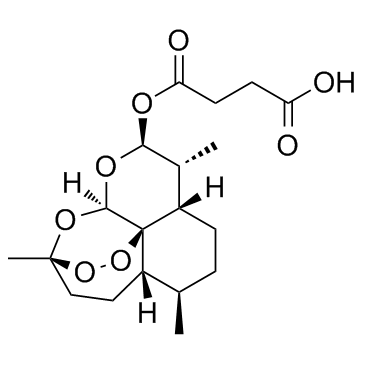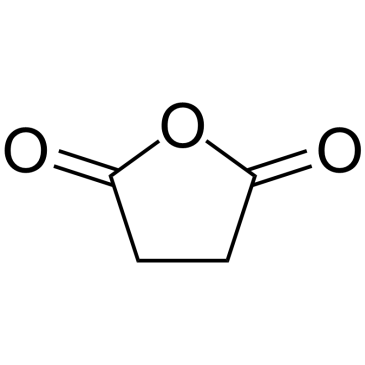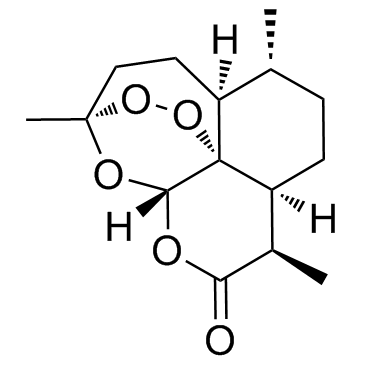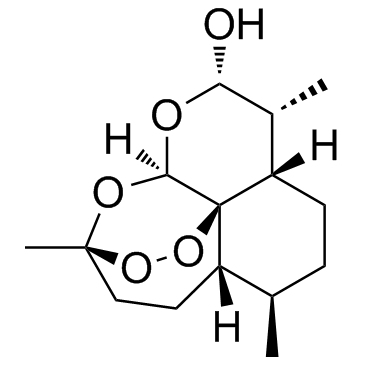Artesunate
Modify Date: 2024-01-02 15:14:13

Artesunate structure
|
Common Name | Artesunate | ||
|---|---|---|---|---|
| CAS Number | 88495-63-0 | Molecular Weight | 384.421 | |
| Density | 1.3±0.1 g/cm3 | Boiling Point | 507.1±50.0 °C at 760 mmHg | |
| Molecular Formula | C19H28O8 | Melting Point | 132-135ºC | |
| MSDS | USA | Flash Point | 175.6±23.6 °C | |
Use of ArtesunateArtesunate is an inhibitor of both STAT-3 and exported protein 1 (EXP1). |
| Name | Artesunate |
|---|---|
| Synonym | More Synonyms |
| Description | Artesunate is an inhibitor of both STAT-3 and exported protein 1 (EXP1). |
|---|---|
| Related Catalog | |
| Target |
Stat-3 EXP1 |
| In Vitro | Artesunate is an inhibitor of both STAT-3[1] and exported protein 1 (EXP1)[2]. Artesunate treatment for 24 h causes a significant increase in the levels of reactive oxygen species (ROS) in a dose-dependent manner in both cell lines. Moreover, Western blotting shows that the levels ofγ-H2AX are significantly elevated when cancer cells are treated with Artesunate in the higher dose range for 24 h. Artesunate also shows a time-dependent effect on the level of RAD51 in A2780 and HO8910 cells. In two types of non-malignant cells, normal human fibroblasts and immortalized epithelial cells, FTE-187, the level of RAD51 is not altered by Artesunate. In A2780 cells, the level of RAD51 mRNA is indeed decreased by the addition of Artesunate, in a dose-dependent manner. Correspondingly, the promoter activity of RAD51 is significantly inhibited by Artesunate. In contrast, the RAD51 mRNA level in H8910 cells is not affected by Artesunate[3]. |
| In Vivo | Tumor growth is significantly reduced in the group receiving combined treatment of Artesunate and cisplatin (P<0.01). In comparison, Artesunate alone has no significant effect on the growth of tumor xenografts for both cell lines[3]. |
| Kinase Assay | After treatment with Artesunate for 24 h, cells are harvested and lysed in 1×cell lysis buffer. Total proteins of 15 to 25 μg are separated by SDS-PAGE and transferred to polyvinylidenedifluoride (PVDF) membranes. Membranes are blocked with 5% non-fat milk for 1 to 2 h at room temperature and then probed with primary antibodies and incubated at 4°C overnight. After extensive washing with TBS-T, membranes are incubated with appropriate HRP-conjugated secondary antibody for 1 h at room temperature, and then are detected by Western ECL-enhanced luminol reagent [3]. |
| Cell Assay | A2780 and HO8910 cells are cultured in RPMI 1640, Normal human fibroblasts (NHF) in DMEM, and FTE-187 in M199, supplemented with 10% fetal bovine serum, 100 units/mL penicillin, and 100 mg/mL streptomycin. All the cells are incubated in a humidified atmosphere of 95% air and 5% CO2. Artesunate is applied to the cultured cells at the concentration of 0, 5, 10, 25, or 50 µg/mL for various periods. The reactive oxygen species (ROS) production following Artesunate treatment is determined. Briefly, cells are loaded with 5 μM of CM-H2DCFDA and incubated at 37°C for 20 min after treatment with Artesunate. Cells are resuspended using preserving fluid and analyzed with a FACSCanto II. The peak excitation wavelength for oxidized CM-H2DCFDA is 490 nm and emission is 530 nm[3]. |
| Animal Admin | Four to six weeks old female athymic nude mice (BALB/c, nu/nu) are used. A2780 and HO8910 cells are harvested and resuspended in 0.1 ml of PBS, 5×106 cells/0.2 mL are injected subcutaneously into the left inguinal area of the mice. Two weeks later, mice bearing tumors (~70 mm3 for A2780 and HO8910) are randomly divided into 4 groups. Artesunate is administered daily via i.p. injection at doses of 50 mg/kg alone for 16 days. The tumor growth is monitored every other day. Tumor volume is determined by the formula 1/2a×b2 where a is the long diameter (mm) and b is the short diameter (mm)[3]. |
| References |
| Density | 1.3±0.1 g/cm3 |
|---|---|
| Boiling Point | 507.1±50.0 °C at 760 mmHg |
| Melting Point | 132-135ºC |
| Molecular Formula | C19H28O8 |
| Molecular Weight | 384.421 |
| Flash Point | 175.6±23.6 °C |
| Exact Mass | 384.178406 |
| PSA | 100.52000 |
| LogP | 2.94 |
| Vapour Pressure | 0.0±2.8 mmHg at 25°C |
| Index of Refraction | 1.544 |
| Storage condition | Room temp |
| Water Solubility | acetone: soluble33.4mg/mL |
|
~97% 
Artesunate CAS#:88495-63-0 |
| Literature: COUNCIL OF SCIENTIFIC AND INDUSTRIAL RESEARCH Patent: WO2004/50661 A1, 2004 ; Location in patent: Page 7 ; |
|
~% 
Artesunate CAS#:88495-63-0 |
| Literature: European Journal of Organic Chemistry, , # 1 p. 113 - 132 |
| Precursor 3 | |
|---|---|
| DownStream 0 | |
| 4-Oxo-4-{[(1R,4S,5R,8S,9R,10R,12R,13R)-1,5,9-trimethyl-11,14,15,16-tetraoxatetracyclo[10.3.1.0.0]hexadec-10-yl]oxy}butanoic acid |
| Cosunate |
| Qinghaozhi |
| Saphnate |
| Arteannuinum |
| AsuMax |
| 4-oxo-4-{[(3R,5aS,6R,8aS,9R,10R,12R,12aR)-3,6,9-trimethyldecahydro-3,12-epoxy[1,2]dioxepino[4,3-i]isochromen-10-yl]oxy}butanoic acid |
| PlasMotriM |
| MFCD00866204 |
| PlasMotrin |
| Butanedioic acid, mono[(3R,5aS,6R,8aS,9R,10R,12R,12aR)-decahydro-3,6,9-trimethyl-3,12-epoxy-12H-pyrano[4,3-j]-1,2-benzodioxepin-10-yl] ester |
| vARTESUNATE |




